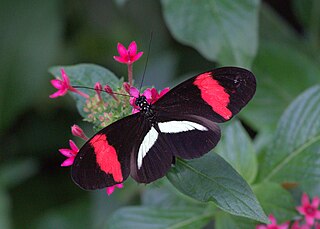
Heliconius erato, or the red postman, is one of about 40 neotropical species of butterfly belonging to the genus Heliconius. It is also commonly known as the small postman, the red passion flower butterfly, or the crimson-patched longwing. It was described by Carl Linnaeus in his 1758 10th edition of Systema Naturae.
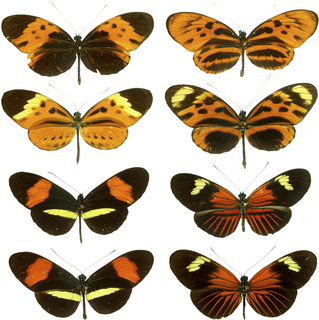
Heliconius comprises a colorful and widespread genus of brush-footed butterflies commonly known as the longwings or heliconians. This genus is distributed throughout the tropical and subtropical regions of the New World, from South America as far north as the southern United States. The larvae of these butterflies eat passion flower vines (Passifloraceae). Adults exhibit bright wing color patterns which signal their distastefulness to potential predators.

Heliconius doris, the Doris longwing or Doris is a species of butterfly in the family Nymphalidae. It is known for being a polymorphic species which participates in various Müllerian mimicry rings throughout Central America and the Amazon rainforest. It is a species of special interest in biological science for the genetic basis and role of polymorphism (biology) in ecology and evolution.

Asterope markii, the dotted glory, is a species of butterfly of the family Nymphalidae. It is found in Brazil, Ecuador, Colombia, Peru, Guyana, and Venezuela.

Mimoides ariarathes is a species of butterfly in the family Papilionidae. It is native to South America.

Callicore excelsior, the superb numberwing or excelsior eighty-eight, is a species of butterfly of the family Nymphalidae. It is found in Colombia, Ecuador, Peru, Brazil, and Bolivia.

Battus belus, the Belus swallowtail is a species of butterfly from the family Papilionidae that is found in Brazil, Colombia, Guatemala, Peru and Venezuela.

Heliconius numata, the Numata longwing, is a brush-footed butterfly species belonging to the family Nymphalidae, subfamily Heliconiinae.
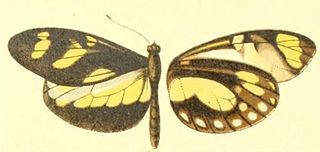
Dismorphia laja is a butterfly in the family Pieridae. It is found in northern South America.

Parides aeneas is a species of butterfly in the family Papilionidae. It is found in the Neotropical realm.

Mimoides pausanias, the Pausanias swallowtail or bluish mimic-swallowtail, is a species of butterfly in the family Papilionidae.
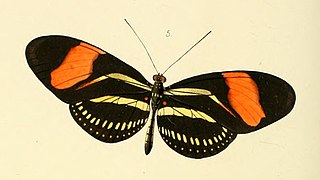
Heliconius hermathena, the Hermathena longwing, is a species of butterfly of the family Nymphalidae. It is endemic to white sand areas of the Amazon basin. Heliconius hermathena is a sand forest nymphalid butterfly and they are typically lowland tropical forest organisms although a handful subspecies can be found in southeastern Brazil and part of the dry forests of Peru.

Heliconius hecuba, the Hecuba longwing, is a species of butterfly of the family Nymphalidae. It lives at altitudes ranging from 1000 to 2400 m in cloud forests in the northern Andes from Colombia to Ecuador.
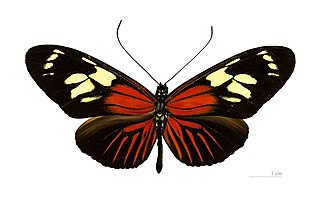
Heliconius burneyi, the Burney's longwing, is a butterfly of the family Nymphalidae. It was described by Jacob Hübner in 1831. It is found in the Amazon basin. The habitat consists of tall forests.

Heliconius elevatus is a butterfly of the family Nymphalidae. It was described by Nöldner in 1901. It is found in the Amazon Basin. The habitat consists of riparian forests.

Heliconius ethilla, the ethilia longwing, is a butterfly of the family Nymphalidae. It was described by Jean-Baptiste Godart in 1819. It is found from Panama to southern Brazil. The habitat consists of marginal forests.

Heliconius aoede, the Aoede longwing, is a species of butterfly of the family Nymphalidae. It was described by Jacob Hübner in 1813. It is found in the Amazon basin. The habitat consists of deep forests.

Heliconius wallacei, the Wallace's longwing, is a butterfly of the family Nymphalidae. It was described by Tryon Reakirt in 1866. It is found from Venezuela and Trinidad to southern Brazil and Peru. The habitat consists of lowland rainforests.

Heliconius eratosignis, the eratosignis longwing, is a butterfly of the family Nymphalidae. It was described by James John Joicey and George Talbot in 1925. It is found in the south-western Amazon basin, from Brazil to Peru and Bolivia. The habitat consists of sandy rainforests.

Napeocles jucunda, the great blue hookwing, is a South American butterfly of the family Nymphalidae. The species was first described by Jacob Hübner in 1808.













